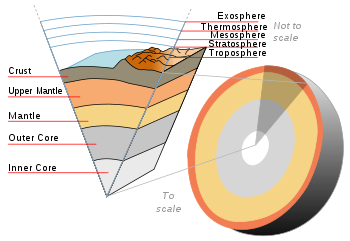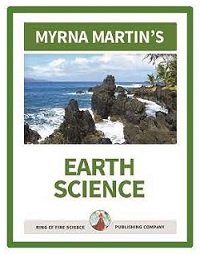Planet Earth is our home
Planet Earth is an Ideal Place to Live
Planet Earth is the third planet from the Sun. It is uniquely suited for plant and animal life. About 70% of our planet is covered with water. The continents and islands make up the remaining 30% that lies above sea level.
People looking to the skies you to believe that the rest of the planets in our Solar System might be a place where other people were living. People thought that Venus would be a wonderful place to live. Today we know that Venus is the hottest planet in our Solar System with a temperature of 462 °C (863 °F) even though Mercury is closer to the Sun.

Interior layers of the Earth, USGS
Earth's Interior layers
Scientists study the Earth's interior using earthquake waves. The lithosphere of our planet includes both the crust and the upper mantle. The boundary between the Earth's crust and the Earth's mantle is named the Moho boundary and is where the speed of earthquake waves change their velocity. The asthenosphere normally lies below the lithosphere. The rocks in this part of the mantle flow like a liquid and can break apart.
The Lithosphere and plate boundaries
The lithosphere is above the asthenosphere and includes the crust and part of the upper mantle. Scientists in the last century discovered our planet's tectonic plate boundaries using earthquake wave patterns.
Iceland sets on top of two plates that are separating. You can walk on both the Eurasian Plate and the North American Plate when you are walking on the island of Iceland. The Iceland volcanoes are fed both by the separating of the two continental plates and the hot spot beneath the island.

Our Earth Science book introduces you to the many topics that are part of a curriculum that studies our planet. Chapters in the book include rocks in the rock cycle, volcanoes worldwide, marine habitats and the oceans. Myrna

the Polar front and earth's atmosphere
Air movement around our planet affects many parts of our life. Polar air flows down from the north pole creating the polar front. Warm air from the Caribbean meets the polar front air causing turbulent air that can create tornadoes in the great plains area of the United States.
The Earth's is surrounded by gases that form our atmosphere. We live at the bottom of the atmosphere that is held to the Earth by gravity. When solar energy from the Sun strikes the atmosphere above the North Pole living near the North Pole are able to view the Northern Lights.
KIDS FUN Science Bookstore
Check out Myrna Martin's award winning textbooks, e-books, videos and rock sets. The Kids Fun Science Bookstore covers a wide range of earth science topics. Click here to browse.










